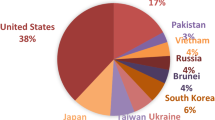Abstract
Internet users communicate with each other in various ways: by Emails, instant messaging, social networking, accessing Web sites, etc. In the course of communicating, users may unintentionally copy files contaminated with computer viruses and worms [1, 2] to their computers and spread them to other users [3]. (Hereafter we will use the term “threats”, rather than computer viruses and computer worms). The Internet is the chief source of these threats [4].
Access this chapter
Tax calculation will be finalised at checkout
Purchases are for personal use only
Similar content being viewed by others
References
N. Weaver, V. Paxson, S. Staniford, R. Cunningham, “A taxonomy of computer worms”, In The First ACM Workshop on Rapid Malcode (WORM), 2003.
S. Staniford, V. Paxson, N. Weaver, “How to own the internet in your spare time”, Proceedings of the 11th USENIX security symposium, 2002.
J. Balthrop, S. Forrest, M. E. J. Newman, M. M. Williamson, “Technological networks and the spread of computer viruses”, Science 304, 527, 2004.
Symantec Internet Security Threat Report, Jan–June 2004.
X. Zhang, C. Li, W. Zheng, “Intrusion prevention system design”, Proceedings – The fourth international conference on computer and information technology, 386–390, 2004.
Y. Tang, S. Chen, “Defending against internet worms. A signature based approach”, IEEE INFOCOM, 2005.
A. Gupta, R. Sekar, “An approach for detecting self-propagating email using anomaly detection”, In Proceedings of the international symposium on recent advances in intrusion detection, Sep 2003.
V. Yegneswaran, P. Barford, S. Jha, “Global intrusion detection in the DOMINO overlay system”, In Proceedings of NDSS, San Diego, CA, 2004.
P. Blackburn, “Quarantining DHCP clients to reduce worm infection risk”, http://www.giac.org/certified professionals/practicals/gsec/3472.php
R. Pastor-Satorras, A. Vespignani, “Epidemics and immunization in scale-free networks”, http://arxiv.org/abs/cond-mat/0205260, 2002.
M. Tubi, R. Puzis, Y. Elovici, “Deployment of DNIDS in social networks”, IEEE ISI, 2007.
R. Huerta, L. S. Tsimring, “Contact tracing and epidemics control in social networks”, Physical Review E, 66, 056115, 2002.
M. E. J. Newman, “The structure and function of complex networks”, SIAM Review, 45(2), 167–256, 2003.
C. C. Zou, D. Towsley, W. Gong, “Email virus propagation modeling and analysis”, Technical Report TR-CSE-03–04, University of Massachussets, Amherst, 2004.
A. L. Barabasi, R. Albert, H. Jeong, “Scale-free characteristics of random networks: the topology of the world-wide web”, Physica A 281, 69–77, 2000.
A. L. Barabasi, R. Albert, “Emergence of scaling in random networks”, Science 286, 509, 1999.
M. E. J. Newman, “The spread of epidemic disease on networks”, Physical Review. E, 66, 016128, 2002.
R. Pastor-Satorras, A. Vespignani, “Epidemic spreading in scale-free networks”, Physical Review Letters, 86(14), 3200–3203, 2001.
D. H. Zanette, M. Kuperman, “Effects of immunization in small-world epidemics”. Physica A, 309, 445–452, 2002.
R. Pastor-Satorras, A. Vespignani, “Immunization of complex networks”, Physical Review E, 65, 036104, 2002.
J. R. Tyler, D. M. Wilkinson, B. A. Huberman, “Email as spectroscopy: automated discovery of community structure within organizations. Communities and technologies”, M. Huysman, E. Wenger, V. Wulf (Eds), pp. 81–95, 2003.
J. Scott, “Social network analysis: a handbook”, Sage Publications, London, 2000.
S. P. Borgatti, M. G. Everett, “A graph-theoretic perspective on centrality”, Social Networks, 28(4), 466–484, 2006.
L. C. Freeman, “Centrality in social networks conceptual clarification”, Social Networks, 1, 215–239, 1979.
M. G. Everett, S. P. Borgatti, “The centrality of groups and classes”, Mathematical Sociology, 23(3), 181–201, 1999.
K. Park, “Scalable protection against ddos and worm attacks. DARPA ATO FTN project AFRL contract F30602–01–2–0530”, Purdue University, West LaFayette, 2004.
S.P. Borgatti, “Centrality and AIDS”, Connections, 18(1), 112–114, 1995.
F. Harary, R. Z. Norman, D. Cartwright, “Structural models. An introduction to the theory of directed graphs”, John Wiley and Sons, New York, 1965.
L.C. Freeman, “A set of measuring centrality based on betweenness”, Sociometry 40, 35–41, 1977.
M. E. J. Newman, “Scientific collaboration networks. II. Shortest paths, weighted networks, and centrality”, Physical Review E, 64, 016132, 2001.
U. Brandes, “A faster algorithm for betweenness centrality”, Journal of Mathematical Sociology, 25(2), 163–177, 2001.
R. Puzis, Y. Elovici, S. Dolev. “Fast algorithm for successive computation of group betweenness centrality”, Physical Review E, 76(5), 056709, 2007.
M. E. J. Newman, “A measure of betweenness centrality based on random walks”, http://arXiv.org/abs/cond-mat/0309045, 2003.
R. G. Downey, M. R. Fellows, “Parametrized computational feasibility”, Feasible Mathematics, 2, 219–244, 1995.
R. Puzis, M. D. Klippel, Y. Elovici, S. Dolev, “Optimization of NIDS placement for protection of intercommunicating critical infrastructures”, Springer LNCS, EuroISI, 2008.
Author information
Authors and Affiliations
Corresponding author
Editor information
Editors and Affiliations
Rights and permissions
Copyright information
© 2010 Springer Science+Business Media, LLC
About this chapter
Cite this chapter
Puzis, R., Tubi, M., Elovici, Y. (2010). Optimizing Targeting of Intrusion Detection Systems in Social Networks. In: Furht, B. (eds) Handbook of Social Network Technologies and Applications. Springer, New York, NY. https://doi.org/10.1007/978-1-4419-7142-5_25
Download citation
DOI: https://doi.org/10.1007/978-1-4419-7142-5_25
Published:
Publisher Name: Springer, New York, NY
Print ISBN: 978-1-4419-7141-8
Online ISBN: 978-1-4419-7142-5
eBook Packages: Computer ScienceComputer Science (R0)




